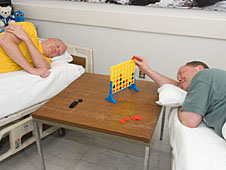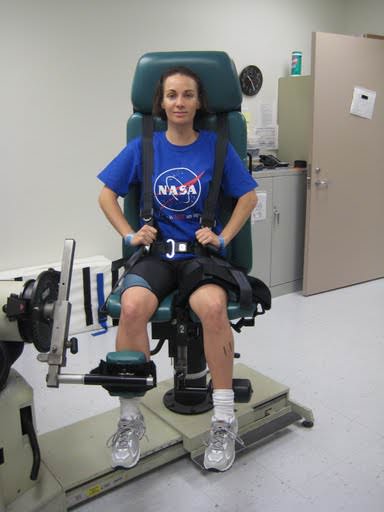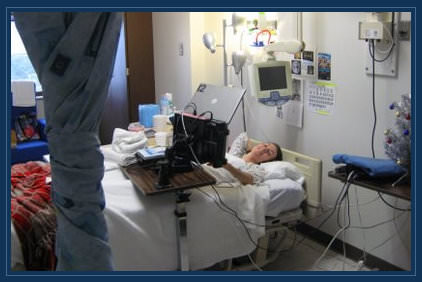If you don’t quite have the right stuff, but always thought being an astronaut would be cool, here’s a way for you to contribute to the US space program. Go to bed. With NASA. “I would absolutely recommend it. It was one of the most amazing experiences of my life,” said Heather Archuletta, who has participated in three different studies for the Human Test Subject Facility (HTSF) at the Johnson Space Center. These ongoing studies use long-term bed rest to simulate the effects of micro-gravity an astronaut would experience during extended space flight. “This is a great opportunity for the general public to help NASA with their scientific research,” said John Foster, who works for Solitaire Creative Services, a company that promotes the studies.
“This is one of NASA’s biggest barriers for sending humans to Mars,” Archuletta told Universe Today. “If they can find a way around bone demineralization, wow, that would really boost the possibilities for human spaceflight.”
NASA is planning a series of studies that support the scientific needs of the space program. The studies will be conducted over the next ten years, and currently, NASA is looking to fill spots in 87-day bed rest studies and a lunar analog feasibility study.
For the bed rest study, participants are placed in bed with the head of the bed tilted down at a minus-six-degree incline. The Lunar Analog Feasibility Study is a 21-day study to demonstrate if it is possible to simulate 1/6 G lunar gravity using bed rest.
“Participants are compensated for their time and expenses,” said Foster. “For example, a participant who completed a 60-day study was paid approximately $13,800.”
“I know they desperately need more healthy females,” Archuletta said. “It seems people think only guys can do these studies, so it seems harder to get women.”
Archuletta, who is also known as the “Pillow-naut” from her blog about her experiences, Pillow Astronaut, said amazingly, the studies simulate very well what astronauts experience in space. “You wouldn’t think that something as simple as tilting the body would mimic what astronauts experience, but it affects your vestibular system the same way and you get the same exact fluid shift where all the blood pools in your head. You get a little bit of muscle atrophy and some bone mineral loss, and they see the same exact lowering in plasma volume and lower heart rate. Almost everything that happens in space they can do with tilting the bed. That was major news for me.”
She said the first week of being in bed is the hardest part of the study. “When they put you in the head-down position, it kind of messes with the inner ear and your equilibrium,” Archuletta said. “They warned me about it, but I didn’t give it much credence, because I thought, ‘you’re lying down, how hard can it be?’ But you get a blood rush to the head, so my teeth were throbbing and I had a headache.”

She also would get dizzy when she turned her head quickly, which again, mimics what many astronauts experience in space. “I have been able to talk with two different astronauts and they both said, yes, the first few days you are on orbit, the veteran astronauts tell them not to turn their head quickly because when you are weightless it messes with the vestibular system.”
Those symptoms passed in about a week, Archuletta said. “It is amazing what the body can adapt to. All of a sudden my body just said, ‘OK, this is our new reality and we’ll deal with it.’ Within a couple of weeks I felt normal and actually getting up was the hard part. You get used to lying down and it actually starts to feel normal.”
But the benefits of participating outweighed any discomforts she went through. “You have tons and tons of free time. I tore through about 30 books. You have your own room but there is a common room where we can play games and talk, but I worked a little while I was there,” said Archuletta, who works as a consultant for an IT company and also is a freelance writer. “But mostly it was nice just to catch up on a lot of things I’d wanted to do for a while.”
But don’t expect to be chosen to participate if you plan to just play video games for three months. “They are really looking for people who come in with goals,” Archuletta said, “such as one person there learned Spanish, I learned sign language, and another person brought their guitar and wrote songs. They want people who have ideas about how to keep themselves busy because they will be less likely to get restless.”
Archuletta said the question she gets asked most often is if she got bored. “Absolutely not,” she said. “It is a very busy testing schedule when you first come, so you go through a lot of physical exertion before the bed rest phase; they keep you very busy. Once you are in bed you do get a lot of free time, but you are being monitored. They take vitals a couple of times a day, and make sure you are doing OK. You stretch a couple times a day so you don’t get blood clots, but you can’t outright exercise. But you get a massage every other day – that’s definitely one of the good parts! I don’t think the astronauts get that in space!”

The studies are done at the University of Texas Medical Branch in Galveston, Texas. Participants will live in a special research unit for the entire study and be fed a carefully controlled diet. The first 11-15 days of the 87-day study, participants undergo tests, but are not on bed rest. The next 60 days participants are constantly in bed, (except for limited times for specific tests) with their head tilted downward slightly. Then there are 14 days to recover, to allow the body to get back to normal.
Participants must be nonsmokers who are in good health with no history of cardiovascular, neurological, gastrointestinal, or musculoskeletal problems.
Interested?
More information on the 87-day bed rest study.
More information on the 21-day Lunar Analog study
Contact the Human Test Subject Facility at 1-866-JSC-TEST (1-866-572-8378)
Pillow Astronaut’s select pages on just her experiences during the study.

